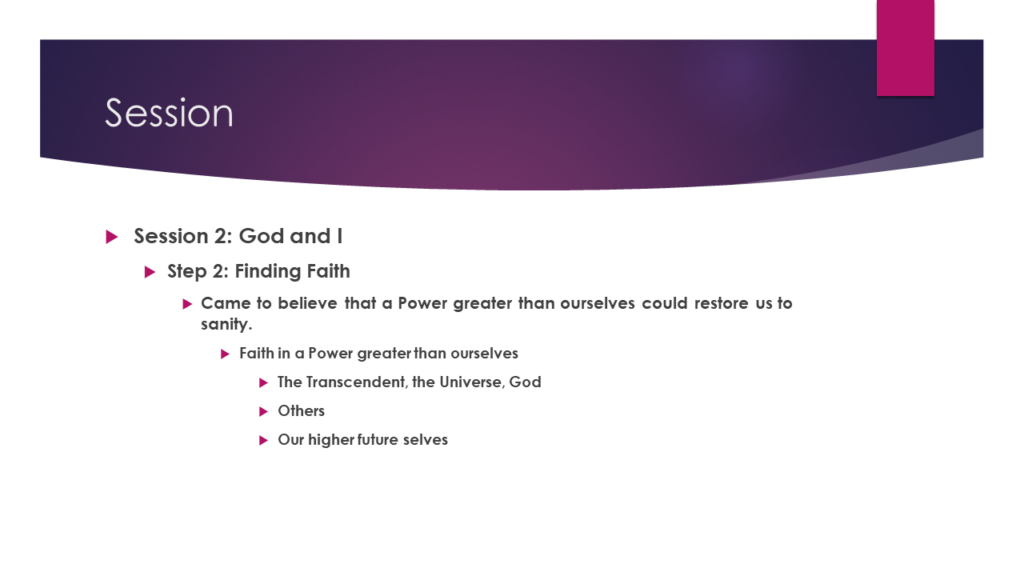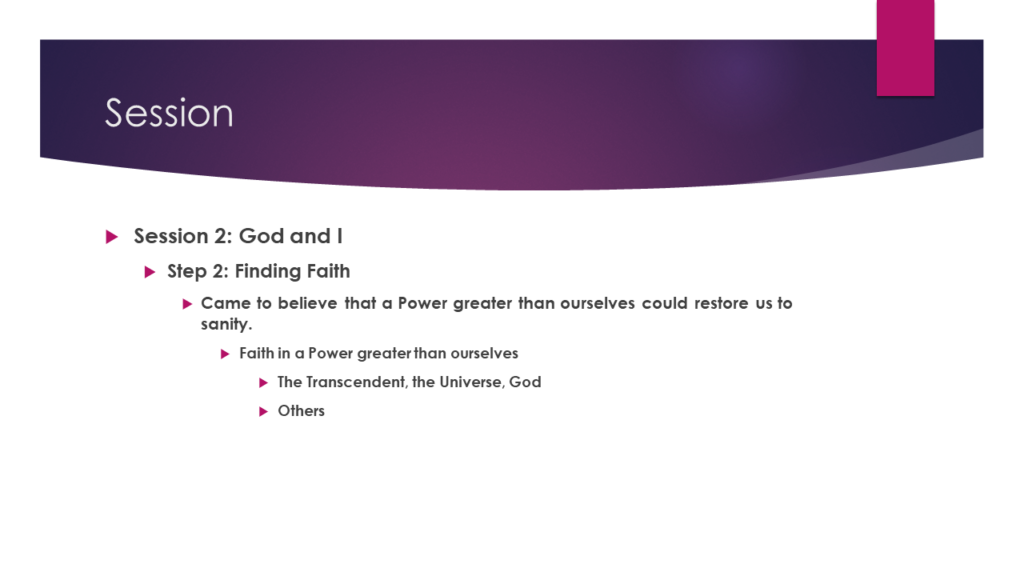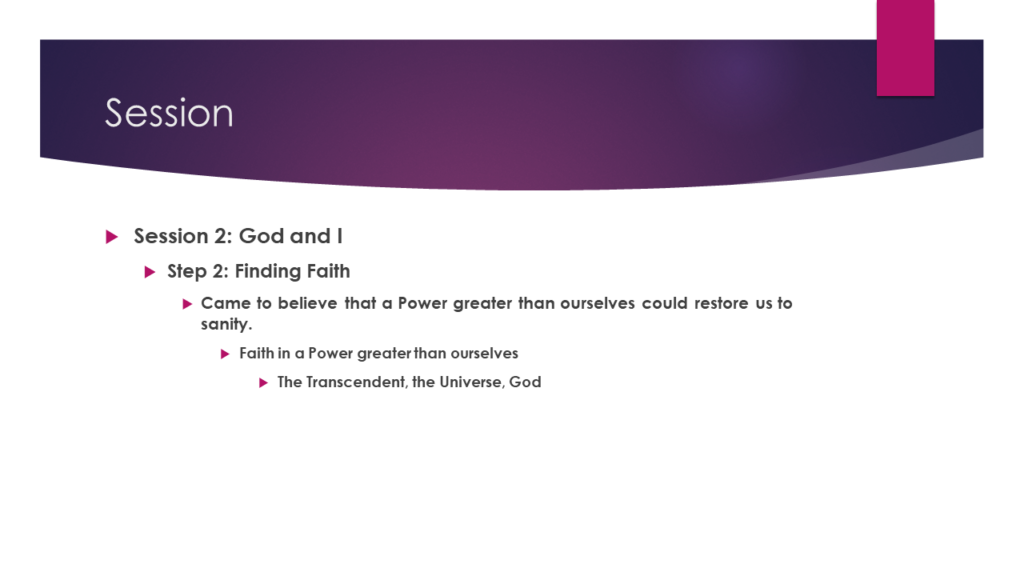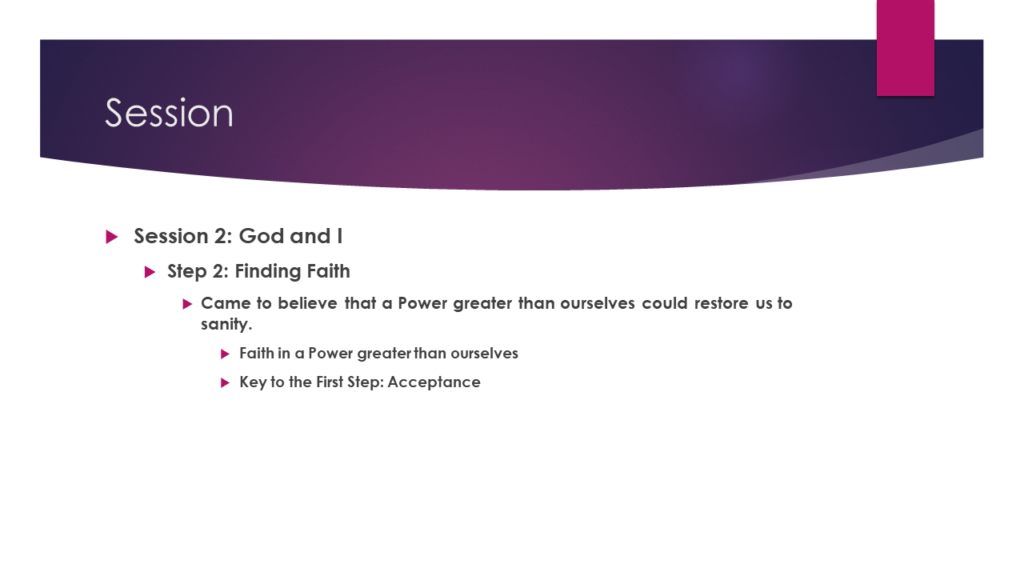Step 2: Finding Faith
In this session, we’ll start by looking for ways that we can find the Power that we need outside of ourselves, especially in the Transcendent. Then, we’ll examine the differences between belief in the Transcendent (faith) and trust in the Transcendent (hope). Here’s where Step 2 comes in.

“Came to believe that a Power greater than ourselves could restore us to sanity.” This step is tightly packed. We would do well to unpack it.

“Came to believe.” Nothing in our world of human experience has been up to the task we’ve set for it. No person, place, or thing has provided us with what we needed to make us truly happy. Neither our own strength nor anything else we’ve tried has provided us with control of our destiny. Yet, there are people living happy, successful lives. We’ve seen them. We may even have asked them how they did it, although chances are we didn’t imagine that what they did would work for us. Remember, “I can’t imagine?” We’ve never experienced anything that’s consistently worked, and yet, we’ve seen the evidence that something does. At this point, we have no choice but to believe that it exists, though we don’t know what it is. We know what we need it to do for us, though.

“A Power greater than ourselves.” We’re powerless and our lives have become unmanageable. What we need now is something or someone greater than ourselves. We talked about it when we considered what spirituality is. We need something Transcending our weakness. We’ve done our best, but our best hasn’t been good enough. We’ve failed. We need a source of power that we can draw on to direct us, to move us forward, and to empower us to establish those connections we so deeply long for. Despite our doubts and hesitations, evidence tells us that such a Power exists. What do we expect this Power to be able to do for us?

Restore us to sanity.” Albert Einstein is credited with providing us with the best possible definition of it. “Insanity,” he said, “is doing the same thing over and over and expecting different results.” When we consider the second step, we may, at first, be inclined to complain, “Restore me to sanity? How dare you imply that I’m insane.” But then we’re invited to look back on our past attitudes and behaviors. Haven’t our struggles to control our lives and our destinies always ended in failure, sooner or later? When the aircraft of life becomes disoriented, we keep clinging to the control yolk, expecting this time we won’t wind up in a disastrous tailspin. Yet, often, we do. What is our hope now? That there’s a Power greater than ourselves that can liberate us from the insane cycle of futility.

Our discussions on spirituality focused on interconnectedness. We talked about a three-dimensional interconnection: a relationship with the Transcendent, the Universe, or God, with others, and with our own future selves. Where can we look to find a Power greater than ourselves in which we can believe?

Our focus must be on the connection between us and a Power greater than ourselves. We have to take our connection with our future selves out of the running. We can’t be our own higher Power.

That leaves our connection with the Transcendent and with others. Of course, others are certainly a power greater than ourselves, whether we look at all of humanity, groups (like religious or support groups), or our social circle. It’s tempting to look to these other groups or individuals to be our Higher Power, but can be very tenuous choice. Not only are they subject to all the foibles and weaknesses that we are, but sooner or later, they’ll come to resent our dependence on them. No matter how much we may love and respect someone or some group, asking them to be our savior is asking a little too much of them, don’t you think? We’ll always be disappointed in them because, after all, they, too, are only human. As individuals, they’re as subject to human weaknesses as we are, and they’re subject to change over time. Looking to others to restore us to sanity is better than not looking at all, but there are better options.
We can let our natural sense of awe guide us.

When we stand silently and behold the earth in all its wonder, and the array of galaxies and stars that surround us, we can begin to understand the words of the psalmist who wrote, “When I see your heavens, the work of your fingers, the moon and stars that you set in place—what is humankind that you are mindful of us, or we, the children of mankind, that you care for us?” [Psalm 8:4-5]

The name that we give to the great Transcendent is not important. Nor is it important that we understand the Transcendent. Clearly, since the Transcendent encompasses us and is greater than us, our understanding pales before it and our words become mere stammering. Let’s choose to call the Transcendent “God.” Yet nothing we say about God is entirely true. Whatever characteristics we attempt to apply to God fall short of the reality: God’s goodness, truth, and beauty far surpass anything we can know. Even saying that God exists is only partly true, because nothing else in the universe exists in the way God does. Happily, we’re not asked to understand God’s existence. We’re only asked to accept it from what we experience of the universe, from what we’ve gleaned from the wisdom of past generations, and from what we’ve observed in the lives of others.
The key to overcoming our powerlessness and healing our disconnection from reality—our spiritual illness—is to acknowledge the existence of God in whatever sense we may use that word. All that we need to say is that there is a personal Transcendent who can supply the power we need to overcome our shortcomings. That is the essence of faith. Please don’t get confused about that word. People—even the Judeo-Christian Scriptures—misuse it frequently. For our purposes, faith is simply the acknowledgment of that Power greater than ourselves that is capable of restoring us to sanity—the Power we call God. In short, powerlessness and unmanageability says, “I can’t do it.” Faith says, “God can.” It’s no more profound nor complicated than that.

What the second step offers us is nothing less than a renewed relationship with reality. Until we take this step, we remain mired in illusion. We’ve created an illusion of ourselves. We think we really are what and who we pretend to be. The first step has already put cracks in that belief. Not only that, but we’ve also created an alternative world where people, places, and things can be simply what we want them to be. We fall in love with people’s potential and ignore who they really are. When places and things don’t live up to our expectations—our demands—we’re either disappointed or downright angry. If we understand that those beliefs are insane, and we’re ready to be restored to sanity, accepting reality as it is becomes a decision of primary importance. Acceptance is the key. We start to see the need to accept ourselves as we are, with all our warts and limitations. We become ready to accept others as they are, rather than as we want them to be. We can now let go and allow places and things to just be themselves, rather than tools for our purposes. Whenever we’re anxious, frustrated, or angry, it’s because we’re unwilling to accept reality as it is. Now, at last, we can accept that there’s a Power greater than ourselves that can restore us—and our grasp of reality—to sanity.
That brings us to the end of Step Two. In a moment, we’ll complete the restoration of our interconnection with God through our discussion of Step Three.
